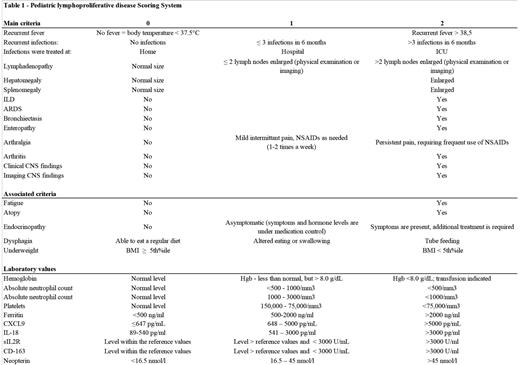Introduction. Pediatric lymphoproliferative disorders (PLPD) encompass a wide spectrum of immune dysregulation conditions with heterogeneous clinical presentation and lab abnormalities. The underlying mechanisms of PLPD are diverse, including dysregulated differentiation of immune cell populations, aberrant recruitment of lymphocyte populations, and/or retention and pathologic survival of lymphocytes. Many PLPD are associated with inborn or acquired genetic factors impacting immune function. Standardized measures to characterize clinical and biological factors in PLPD patients and responses to therapy are lacking. One common feature in PLPD patients is activating IFNg signaling. Ruxolitinib is a drug that blocks hyperactivated IFNg signaling through the JAK-STAT pathway. The goal of this study is to describe the clinical responses of PLPD patients to ruxolitinib.
Methods. Medical charts were reviewed to identify patients with PLPD treated with ruxolitnib at Texas Children's Hospital over a 7-year period. Clinical manifestations (recurrent fever, fatigue, lymphadenopathy, recurrent infections, pulmonary disease, endocrinopathy, enteropathy, hepatosplenomegaly, arthritis, CNS symptoms, atopy, dysphagia, underweight), lab values of complete blood count and pathologic inflammation markers (CXCL9, ferritin, sIL2R, IL-18, CD163, neopterin) were categorized with a severity system indicating: 0 no clinical signs and normal lab values; 1 mild to moderate symptoms and abnormal lab values; 2 severe symptoms, highly abnormal lab values (table 1). Total score was computed before and during the addition of ruxolitinib. Complete response (CR) represented a reduction of the total score to 0. Partial response (PR) signified reduction of criteria score ≥ 30% from the baseline with no progression or manifestation of new symptoms. Progression of the disease or improvement < 30% was marked as no response (NR).
Results. Chart review identified 19 children and young adults with PLPD who received treatment with ruxolitinib (median age 8.5 years; range 1.2 to 21.6 years). Underlying disease states driving PLPD included HLH, inborn errors of immunity, juvenile rheumatoid arthritis, macrophage activation syndrome, malignant atrophic papulosis of Degos, Aicardi-Goutierres Syndrome, and T-cell large granular lymphocytic leukemia.Genetic variants known or predicted to be damaging were identified in 15 cases (79%), including STAT1, STAT3, TREX1, OFD1, NLRP12, NLRP4, UNC13, PRF1, AP3D1 and mosaic genome-wide paternal uniparental disomy. While 79% of patients received ruxolitinib in combination with other immune suppressants, 21% received only ruxolitinib out of which half received it as front-line therapy.
Based on the PLPD Scoring System, overall response rate to ruxolitinib was 73.7%, with 5.3% achieving CR, and 68.4% PR. Overall survival on this study was 84.2% with median 11 months follow-up (range: 0.5 month to 7.1 years). Three patients died due to uncontrolled disease progression. Six patients in whom hematopoietic cell transplant was deemed essential for cure survived to conditioning. Toxicities potentially related to ruxolitinib included grades 1 to 4 cytopenias and grade 1 elevated liver enzymes.
Conclusion. PLPD represents a population with overall poor outcomes. We developed standardized staging and response metrics to characterize extent of immune dysregulation and response to therapy. Ruxolitinib represents a potential “precision” therapeutic intervention for patients with pathologic IFNg pathway activation. Ruxolitinib was well-tolerated in this high risk population, and was associated with positive responses in the majority of patients. This study supports expansion of prospective studies to validate the PLPD Scoring System and to optimize therapeutic strategies to manage immune dysregulation, including ruxolitinib.
OffLabel Disclosure:
Forbes Satter:incyte: Consultancy; orchard: Other: adjudication committee; enzyvant: Consultancy; csl behring: Consultancy; ADMA: Consultancy; grifols: Consultancy; takeda: Consultancy; horizon: Consultancy. Allen:Sobi, Inc: Consultancy.
Ruxolitinib previously has been approved by the Food and Drug Administration for the treatment of myelofibrosis and graft-versus-host-disease. . Positive clinical responses to ruxolitinib have also been described in some patients with refractory hemophagocytic lymphohistiocytosis (HLH), in patients with STAT1, STAT3, STAT5b, and STAT6 gain-of-function (GOF) and in patients with chronic active EBV. One common feature in pediatric lymphoproliferative diseases is activating IFNg signaling. Ruxolitinib is a drug that blocks hyperactivated IFNg signaling through the JAK-STAT pathway. So the goal of this study is to describe the safety and efficacy of ruxolitinib on patients with PLPD


